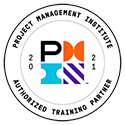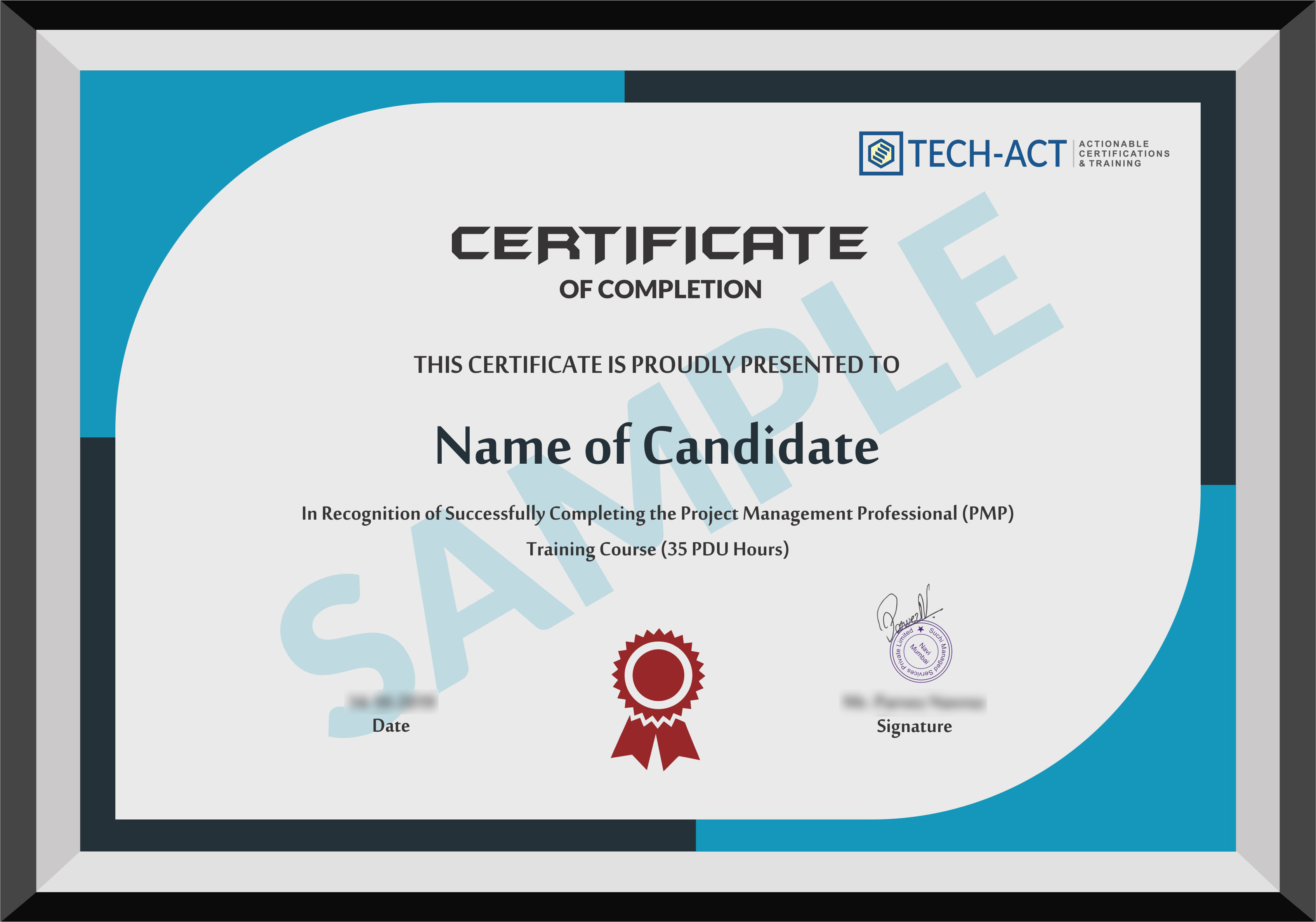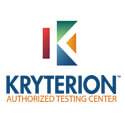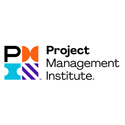Request More Information
Upcoming Batches: Online Instructor-led Training
22
Aug28
Aug10
SEP18
SEP01
OCT09
OCT22
OCT30
OCTPMI’s Project Management Professional or PMP certification is one of the gold standards of project management certification. Accredited and in demand by businesses all around the world, PMP validates your expertise in performing the role of a project manager at optimum best helping you drive and lead teams as well as projects successfully.
Simply put, PMP infers that you can speak as well as interpret the global concepts of project management and lets you connect with a world of PMP experts and professionals worldwide. Long story short, PMP is your doorway to become a project ninja.
Course Objectives
PMI’s PMP certification course is meticulously devised to make sure that you clear the quintessential PMP exam at the first go. Tech-Act’s hands-on approach for training entrusted by hundreds of learners will assist you to grasp the key knowledge areas and project management tricks to become a project management expert. The course:
Improves self-confidence as a project manager
Builds skillsets and knowledge
Boosts project efficiency
Improves team management skills
Helps you drive and implement challenging projects
Helps you learn skills to deliver projects on time and within time
Cultivates project leadership skills
Benefits are manifold when you pursue the PMI’s PMP certification course:
- Improves self-confidence, builds skillsets and knowledge
- Boosts project efficiency and performance
- Improves team and employee management
- Helps you drive, implement and lead challenging projects
- Improved career opportunities
- Skills to deliver projects on time and within the stipulated time
- Cultivating leadership skills
Overview
This section covers the information on The Project Management Professional certification from the Project Management Institute. It is an advanced level certification that requires not only a written exam from the candidate but also verifiable non-overlapping field experience and continuing education. It is the most significant industry recognized certification for Project Managers worldwide.
2016 Exam Update
This section covers some of the details of the Project Management Professional Exam Update for January 2016. It highlights the reasons for the change and shows the differences from the current exam iteration.
Fundamentals
This section introduces to the Project Management Institute (PMI) framework for managing projects. It explains the Project Management Body Knowledge and covers some required terminology for the exam.
Initiation Phase
This section explains the the layout of the PMBOK which is a resource available when joining PMI. It explains the project management process, describes the project management constraints, Project Management Charter and the authority it gives to the project.
Planning Part 1
This section explores one of the phase of project management, The Planning phase. It covers the purpose of developing a plan and why it is needed. It explains that project management plan is the result of developing how to manage the constraints of project time, project costs, project requirements and stakeholders.
Planning Project Scope
This section introduces Project Scope Planning phase. It explains scope of project must be measureable, attainable and manageable which can only happen if the scope is clearly defined during the planning phase. It covers the needs and parameters that make up the project scope.
Determining Requirements
This section continues to define the scope of determining the requirements of the project.
Time Management Part 1
This section gives the information on Scheduling the Project. It demonstrates some of the templates and Project Management Scheduling Utilities that can be used for project time management. It discusses the process of estimating the duration of activities within a project and different project management software to show how the duration of activities affect the overall duration of the project.
Cost Management
This section covers the area of cost management for the project. It explains the techniques used to create a budget for the project and relevant tools and techniques to estimate material and labor cost.
Quality
This section discusses how to handle quality management, resources and communications. It covers how to manage quality control, quality assurance and planning for materials and labor management.
Planning for Risks
This section explains the process of Risk Management within Project Management. It covers the concepts of risk tolerance: risk adverse, risk seekers and risk neutral as base for risk management of the project. It discusses the tools and techniques used to identify risks.
Procurements and Stakeholders
This section explains procurement management. It focus on contract execution, fulfillment and termination.
Execution Part 1
This section talks about the transition into the monitoring and controlling while the project is being executed and work packages are being accomplished.
Developing a Plan
This section covers the project planning phase of the project. It explains project task assignments, estimation of duration and costs.
Executing Part
This section discusses the execution phase of a project. It discusses how to manage project work process. It covers the tools and techniques used to manage communication during the project execution. At the end it explains how to keep the stakeholders engaged with the project.
Monitoring and Controlling
This section covers the next phase of Project Management: the Monitoring and Controlling phase. It discusses the importance of setting good controls in place to facilitate project work.
Schedule and Cost Management
This section gives an overview of controlling time management and cost within the project. It demonstrates the close ties between cost, time and scope.
Earned Value Management
This section shows the most common formulas found in the PMBOK and demonstrate how they are used when having to do forecasting for time and cost management within a project.
Monitoring and Controlling Part 2
This section guides through the final work areas of controlling quality, communications, risks, procurements and stakeholders.
Process Analysis
This section covers some of the most common methodologies used in process management such as Six Sigma, Lean and Kanban methods used in project management.
Closing
This section covers 2 areas in the Closing Process Group: Closing the Project or Phase and Closing the Procurements. It explains the importance of this phase and ensure the stakeholder satisfaction, release project teams to other projects and terminate contracts.
Project Management Tasks
This section takes a look into the project management tasks found the January 2016 objectives for the PMP exam. It describes the tasks, skills and techniques and the processes that Project Managers should know and use in their Projects.
CPM Example
This section reviews the Critical Path Method to determine Critical Path. It discusses the formula used to determine float and the method used to determine starts and finishes of each task. It explains how determining the critical path helps answer multiple types of questions that a PMP candidate may be expected to answer.
Earned Value
This section takes a closer look at how to face the challenge of determining the Earned Value (EV). It explains the importance of the PV, Planned Value. It demonstrate how to take the given information to determine the EV of a given scenario.
Schedule Performance
This section discusses how to determine Schedule Performance. The Schedule Performance helps to determine whether the project are ahead of schedule based on time, deliverables or even cost.
Cost Performance
This section focuses on the different formulas, for Cost Performance. Using the basic formula, it shows how to determine what we’ve spent in comparison to what we expected to spend and gets the Cost Variance.
Cumulative Performance
This section covers the Cumulative Indexes that determines whether the project is ahead of schedule or behind schedule, under budget or over budget. It also allows to take a historical look at the project’s cost and schedule performance up to that point.
Forecasting
This section dives into schedule and budget forecasting formulas. It explains the issue of using an ETC, estimate to completion formula. At the end it demonstrates using these formulas will help to forecast in comparison to the Budget at Completion (BAC).
- Best in class trainers
- Practical exposure to challenging projects
- Top-notch amenities
- Exam guidance and preparation
- Authorized training partner for Project Management Institute
- Both online and in-class learning options.
- Yes, our students get training from the best trainers possessing relevant industry experience with proven years of accomplishment offering quality training.
Prominent benefits of PMI’s PMP certification course are as follows:
- Boosts project efficiency and performance
- Improves self-confidence, builds skillsets and knowledge
- Helps you drive, implement and lead challenging projects
- Improves team and employee management
- Skills to deliver projects on time and within the stipulated time
- Improved career opportunities
- Network and authentication attacks
- Computer forensics and email crimes
- Cultivates leadership skills
- High school diploma, secondary or associate degree or equivalent
- Project management knowledge
Also, PMP certification course is apt for:
- Project managers
- Software developers
- Associate project managers
- Team managers/leaders
- Project engineers/executives
- Anyone who aspires to become a project manager
We have a strong track record of providing IT training over the last 10 years and key things that makes our training services attractive to all are:
- Cost: Affordable pricing with money back guarantee.
- Multiple Training Formats: Including Online Instructor Led training; Traditional Class Room Training and Self Paced Learning. The choice is preferred by the learners themselves.
- Personal Attention: Small training class for highest personal attention to students from trainers. Our expected group of students per class will be in the range of 5 to 10.
- Course Administration and Contents: We leverage years of experience in making our training delivery enriching, exciting, fun and simulating for our students.
- Consultative Approach: We help students understand the training landscape and address their individual needs through informed and genuine guidance.
- Delivery Platform: We have successfully leveraged best technology to ensure consistent quality and training delivery for all our students and clients.
Undergoing training through TECH-ACT has high merits. Our trainers are highly experienced and certified. In a highly aggressive IT market, the specialized courses offered by Tech-Act will keep always competitive and make you stand in front.
Testimonials
Disclaimer: Tech-Act is an independent training services provider. Any use of third party trademarks, brand names, products and services is only referential.Tech-Act disclaims any sponsorship, affiliation or endorsement of or by any third parties. Tech-Act is an authorized training partner only where explicitly stated and as listed here.









































